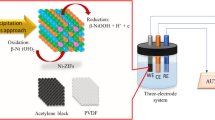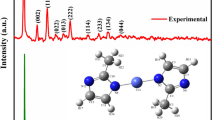Abstract
Facile synthesis of Ni/Co-based zeolitic-imidazolate frameworks (ZIFs) with interconnected rod-shape like particles was successfully achieved using a simple co-precipitation approach. X-ray diffraction (XRD), Fourier transform infrared (FTIR) spectroscopy, field emission scanning electron microscopy, energy-dispersive X-ray and X-ray photoelectron spectroscopy were used to characterise the studied materials. The formation of the NiCo-ZIF bimetallic sample was confirmed by XRD and FTIR studies. The electrochemical behaviour of bimetallic electrode materials was assessed using cyclic voltammetry, constant-current charge/discharge cycling and electrochemical impedance measurements. The specific capacitance of the Ni/Co-ZIF reached 358 C g−1 at a current density of 0.50 A g−1 and cycling stability of 96.5% after 2500 cycles in a three-electrode system. The two-electrode setup for asymmetrical cell for Ni/Co-ZIF//KOH//AC obtained an energy density of 16 Wh kg−1 and power output of 457 W kg−1 with an excellent stability performance (capacity retention of 106% after 2500 cycles). Findings demonstrate that bimetallic Ni/Co-ZIF produced by a room-temperature one-step co-precipitation method could offer great potential for high-performance supercapacitors.
Graphical abstract







Similar content being viewed by others
References
Arunachalam S, Kirubasankar B, Murugadoss V, Vellasamy D, Angaiah S (2018) Facile synthesis of electrostatically anchored Nd(OH)3 nanorods onto graphene nanosheets as a high capacitance electrode material for supercapacitors. N J Chem 42(4):2923–2932. https://doi.org/10.1039/c7nj04335j
Kirubasankar B, Palanisamy P, Arunachalam S, Murugadoss V, Angaiah S (2019) 2D MoSe2–Ni(OH)2 nanohybrid as an efficient electrode material with high rate capability for asymmetric supercapacitor applications. Chem Eng J 355:881–890. https://doi.org/10.1016/j.cej.2018.08.185
Kirubasankar B, Murugadoss V, Angaiah S (2017) Hydrothermal assisted: in situ growth of CoSe onto graphene nanosheets as a nanohybrid positive electrode for asymmetric supercapacitors. RSC Adv 7(10):5853–5862. https://doi.org/10.1039/c6ra25078e
Huang L, Chen D, Ding Y, Feng S, Wang ZL, Liu M (2013) Nickel–cobalt hydroxide nanosheets coated on NiCo2O4 nanowires grown on carbon fiber paper for high-performance pseudocapacitors. Nano Lett 13(7):3135–3139. https://doi.org/10.1021/nl401086t
Xu J, Yang C, Xue Y, Wang C, Cao J, Chen Z (2016) Facile synthesis of novel metal–organic nickel hydroxide nanorods for high performance supercapacitor. Electrochim Acta 211:595–602. https://doi.org/10.1016/j.electacta.2016.06.090
Huang B et al (2018) Two-dimensional porous (Co, Ni)-based monometallic hydroxides and bimetallic layered double hydroxides thin sheets with honeycomb-like nanostructure as positive electrode for high-performance hybrid supercapacitors. J Colloid Interface Sci 532:630–640. https://doi.org/10.1016/j.jcis.2018.08.019
Wang F, Xiao S, Hou Y, Hu C, Liu L, Wu Y (2013) Electrode materials for aqueous asymmetric supercapacitors. RSC Adv 3(32):13059–13084. https://doi.org/10.1039/c3ra23466e
Borhani S, Moradi M, Kiani MA, Hajati S, Toth J (2017) CoxZn1−x ZIF-derived binary Co3O4/ZnO wrapped by 3D reduced graphene oxide for asymmetric supercapacitor: comparison of pure and heat-treated bimetallic MOF. Ceram Int 43(16):14413–14425. https://doi.org/10.1016/j.ceramint.2017.07.211
Usman Tahir M et al (2020) Room temperature and aqueous synthesis of bimetallic ZIF derived CoNi layered double hydroxides and their applications in asymmetric supercapacitors. J Colloid Interface Sci 579(195–204):2020. https://doi.org/10.1016/j.jcis.2020.06.050
Wang X et al (2019) Hydrothermal synthesis of NiCo-based bimetal–organic frameworks as electrode materials for supercapacitors. J Solid State Chem. https://doi.org/10.1016/j.jssc.2018.11.038
Gao S et al (2018) Dandelion-like nickel/cobalt metal–organic framework-based electrode materials for high performance supercapacitors. J Colloid Interface Sci 531:83–90. https://doi.org/10.1016/j.jcis.2018.07.044
Xia H, Zhang J, Yang Z, Guo S, Guo S, Xu Q (2017) 2D MOF nanoflake-assembled spherical microstructures for enhanced supercapacitor and electrocatalysis performances. Nano–Micro Lett. https://doi.org/10.1007/s40820-017-0144-6
Gholipour-Ranjbar H, Soleimani M, Naderi HR (2016) Application of Ni/Co-based metal–organic frameworks (MOFs) as an advanced electrode material for supercapacitors. N J Chem 40(11):9187–9193. https://doi.org/10.1039/c6nj01449f
Ede SR, Anantharaj S, Kumaran KT, Mishra S, Kundu S (2017) One step synthesis of Ni/Ni(OH)2 nano sheets (NSs) and their application in asymmetric supercapacitors. RSC Adv 7(10):5898–5911. https://doi.org/10.1039/c6ra26584g
Rahmanifar MS, Hesari H, Noori A, Masoomi MY, Morsali A, Mousavi MF (2018) A dual Ni/Co-MOF-reduced graphene oxide nanocomposite as a high-performance supercapacitor electrode material. Electrochim Acta 275:76–86. https://doi.org/10.1016/j.electacta.2018.04.130
Di Santo A et al (2018) New coordination polymers based on 2-methylimidazole and transition metal nitroprusside containing building blocks: synthesis, structure and magnetic properties. N J Chem 42(2):1347–1355. https://doi.org/10.1039/c7nj03585c
Wang Y et al (2019) Ultrathin NiCo-MOF nanosheets for high-performance supercapacitor electrodes. ACS Appl Energy Mater 2(3):2063–2071. https://doi.org/10.1021/acsaem.8b02128
Li X, Gao X, Ai L, Jiang J (2015) Mechanistic insight into the interaction and adsorption of Cr(VI) with zeolitic imidazolate framework-67 microcrystals from aqueous solution. Chem Eng J 274:238–246. https://doi.org/10.1016/j.cej.2015.03.127
Dubal DP, Jagadale AD, Patil SV, Lokhande CD (2012) Simple route for the synthesis of supercapacitive Co–Ni mixed hydroxide thin films. Mater Res Bull 47(5):1239–1245. https://doi.org/10.1016/j.materresbull.2012.01.026
Huang M et al (2017) MOF-derived bi-metal embedded N-doped carbon polyhedral nanocages with enhanced lithium storage. J Mater Chem A 5(1):266–274. https://doi.org/10.1039/c6ta09030c
Jiang L et al (2017) Hierarchical Ni–Co layered double hydroxide nanosheets on functionalized 3D-RGO films for high energy density asymmetric supercapacitor. Appl Surf Sci 426:148–159. https://doi.org/10.1016/j.apsusc.2017.07.175
Wang J, Zhong Q, Zeng Y, Cheng D, Xiong Y, Bu Y (2019) Rational construction of triangle-like nickel–cobalt bimetallic metal–organic framework nanosheets arrays as battery-type electrodes for hybrid supercapacitors. J Colloid Interface Sci 555:42–52. https://doi.org/10.1016/j.jcis.2019.07.063
Gogotsi Y, Penner RM (2018) Energy storage in nanomaterials—capacitive, pseudocapacitive, or battery-like? ACS Nano 12(3):2081–2083. https://doi.org/10.1021/acsnano.8b01914
Acknowledgements
The Malaysian Ministry of Higher Education and University of Malaya Grants (FRGS/1/2018/STG07/UM/02/8 and FG034-17AFR) provided full support for this research.
Author information
Authors and Affiliations
Contributions
Conception and design of study:SRM, Acquisition of data: AHAR, Data curation, Writing—Original draft preparation: AHAR, Supervision: SRM, Validation, Writing—Reviewing and Editing: AHAR and SRM
Corresponding author
Ethics declarations
Conflict of interest
The authors declare no competing interests.
Additional information
Publisher's Note
Springer Nature remains neutral with regard to jurisdictional claims in published maps and institutional affiliations.
Supplementary Information
Below is the link to the electronic supplementary material.
Rights and permissions
Springer Nature or its licensor (e.g. a society or other partner) holds exclusive rights to this article under a publishing agreement with the author(s) or other rightsholder(s); author self-archiving of the accepted manuscript version of this article is solely governed by the terms of such publishing agreement and applicable law.
About this article
Cite this article
Rahim, A.H.A., Majid, S.R. Ni/Co-based zeolitic-imidazolate framework pseudocapacitance in asymmetrical cells. J Appl Electrochem 53, 1727–1737 (2023). https://doi.org/10.1007/s10800-023-01888-x
Received:
Accepted:
Published:
Issue Date:
DOI: https://doi.org/10.1007/s10800-023-01888-x




